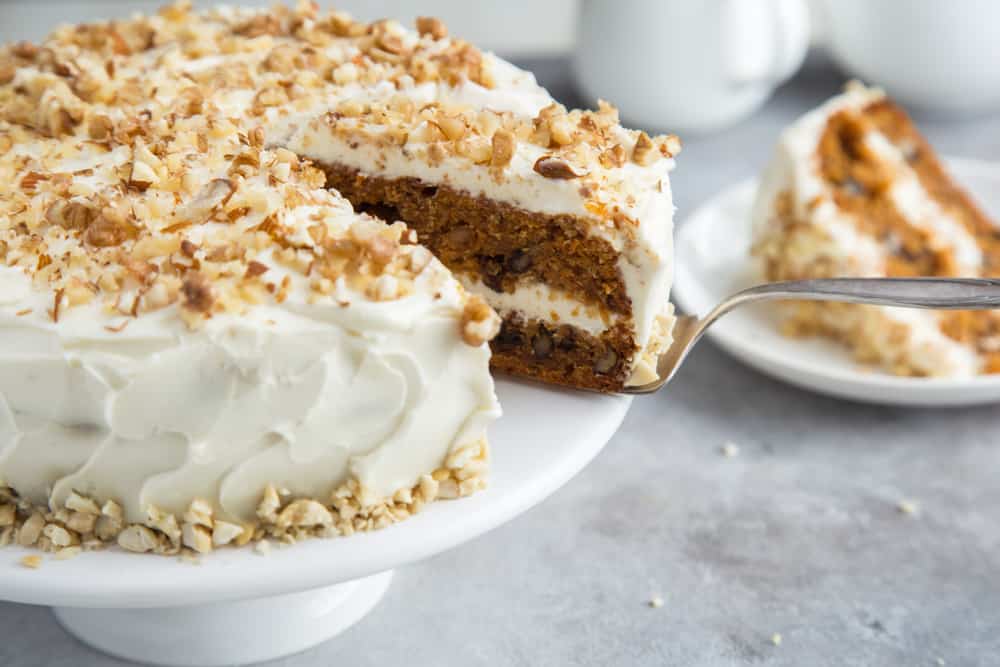In the world of desserts, there are some that are just too iconic to ever lose their popularity. Carrot cake is certainly one of these desserts. Carrot cake does not just have carrots but also nuts as well as spices such as cinnamon, ginger and ground mixed spices. Fruit including pineapple, raisins, and shredded coconut can also be used to add a natural sweetness. With this in mind, where does carrot cake come from?
The exact origin of carrot cake cannot be pinned down by historical records. Some of the earliest sources available show that a form of carrot cake was made in sixteenth-century England, but more well-known records of the actual dish date to 18th-century England.
Are you currently looking to learn more about carrot cake and its origins? Perhaps you are wanting to make the dish as close to its oldest formulation as possible? Regardless of your varied interests, this comprehensive guide will explore everything there is to know about the popular cake. We will take a look at its history, its ingredients, as well as various preparation styles over the years that have made this dish what it is.
What Is Carrot Cake?

A carrot cake is a cake that contains carrots mixed into the batter. Most modern carrot cake recipes have a white cream cheese frosting. Sometimes nuts such as walnuts or pecans are added to the cake batter, and various types of nuts and spices are added as well.
The orange flakes of cut carrot give the cake color and texture, along with sweetness and moisture.
Many recipes have optional ingredients, such as nuts, raisins, pineapple, or coconut.
Carrot cake may be eaten plain, but it is commonly either glazed or covered with white icing or cream cheese icing and walnuts, often cut. Often they are decorated with frosting or marzipan made to look like carrots.
They are popular in the loaf, sheet cake, and cupcake form, and (in the United Kingdom as well as North America) can be found pre-packaged at grocery stores, and fresh at bakeries.
When Was Carrot Cake Invented?
Many food historians believe it originated from carrot puddings eaten by Europeans in the Middle Ages when sugar and sweeteners were expensive and many people used carrots as a substitute for sugar. Variations of the carrot pudding evolved to include baking with a crust (as pumpkin pie), steamed with a sauce, or molded in pans (as plum pudding) with icing.
Who Invented Carrot Cake?
It is hard to pin down, but Antoine Beauvilliers, a former chef to Louis XVI, included a recipe for a “Gâteau de Carottes”, which was popular enough to be copied verbatim in competitors’ cookbooks. In 1824, Beauvilliers had published in London an English version of his cookbook which includes a recipe for “Carrot Cakes” in a literal translation of his earlier recipe.
Why Is Carrot Cake Called Carrot Cake?
Carrot cake is unique amongst desserts in that it is a hearty, rustic type of sweet cake. Although its roots are in England, the cake popularized during the health craze of the late 20th century, carrot cake is regarded as a healthier alternative due to the use of vegetable oil instead of shortening and the addition of a recognized vegetable like carrots.
The name of the dish dates to the 20th century when carrot cake’s popularity increased in the 1980s due to consumers’ perceived benefits of consuming vegetables with their highly caloric baked goods. Today, carrot cake is one of the most popular American desserts.
Does Carrot Cake Taste Like Carrots?
Carrot cakes do not taste like carrots much, if at all. While carrots are present in most recipes, their taste is suppressed by other, more dominant flavors. The taste of the cream cheese frosting, spice mix, and other fruits and nuts are all more prevalent than the actual carrots.
What Kind Of Icing Goes On Carrot Cake?

For the most part, carrot cakes taste like a spice cake topped off with cream cheese, which is the most common type of icing used in this cake. The caramelized brown sugar gives a sweet taste, cream cheese gives a salty and creamy profile, and spices such as cinnamon, nutmeg, and cloves provide a richer taste.
Ingredients
Typical carrot cake ingredients include:
- Grated carrots – and don’t go buying the pre-grated carrots at the grocery store. Whole carrots, peeled and grated on the large side of a box grater will lend the most flavor and moisture.
- Ground cinnamon, ground ginger, and ground nutmeg to balance the sweetness of the carrots with spices.
- 4 large eggs
- Many people use vegetable oil over butter for their cake because they love the moisture and tenderness it adds to the cake. If you insist on butter – that’s totally fine– just melt it and cool it slightly before adding it to the wet ingredients.
- All-purpose flour
- Kosher salt
- Baking powder and baking soda
- Walnuts or pecans – choose whatever nut you prefer, or no nuts at all. I’m Team Walnut.
- Raisins – polarizing but they have my vote.
- Vanilla extract
- Crushed pineapple – but no one is twisting your arm, it’s optional but encouraged.
- Powdered sugar
- Cream cheese
Does Carrot Cake Have Carrots In It?
Yes, carrot cake has typically about 40% of carrots within its ingredient makeup. The carrots need to be peeled and shaved for the best consistency throughout the mixing and baking process.
Does It Have Nuts?
Pecans are usually the nut of choice for carrot cake. If desired, you can substitute the pecans with walnuts. Or feel free to skip the nuts if you want a nut-free carrot cake. No other changes to the recipe are required if you do or do not choose to use nuts in the mixture.
Does Carrot Cake Have Raisins?
Raisins are really a matter of personal taste when it comes to carrot cake. Whether or not you add them is up to your tolerance for the chewy little nuggets—the same goes for chopped walnuts (just be sure to toast them first for better flavor).
But rein it in after that as too many mix-ins will muddy the flavor of the warming spices and could compromise the structural integrity of your ultra-tender cake.
Nutrition
Carrot cake nutrition is often misunderstood.
Saturated fats in carrot cake have a nasty tendency of clogging your arteries and, therefore, increase the risk of heart disease. Butter and coconut oil are full of this type of fat. So, replacing them with olive oil is a good start. Not only do they reduce the saturated fat load, but also make your cake’s texture lighter and more moisturized.
Sugars do more for these cakes than simply make them sweeter. They are essential in getting a light and airy texture due to how they help trap tiny bubbles of air in the cake.
But what might sound like heresy at first, is actually quite possible and can be a healthy alternative. Yes, this cake has to taste sweet. But that sweetness can come from multiple sources other than table sugar.
For example, natural sweeteners such as honey and maple syrup can easily replace store-bought sugar in your cake. They can make your cakes heavier but also add more diversity to the overall taste. And genuine, natural honey or maple syrup is definitely a better source of sweetness than normal sugar.
The natural sweetness in fruits and vegetables is also a terrific alternative. Carrot cakes work well with other vegetables, fruits, and nuts. So, reducing the amount of sugar by 10-30% and using naturally sweet fruits to make the cake can pay great dividends. As a bonus, you receive all the minerals and vitamins in the fruits and nuts as well.
The next time you bake a carrot cake, choose whole grain flour instead of white. This is because the whole grain has the entire grain in the powder, making it more fiber and vitamin-rich.
Another tip is to blend the almonds and replace some of the flour with blended almonds.
Is Carrot Cake Healthy?

Believe it or not, carrots do in fact contain healthy ingredients, such as carrots and nuts, but they are also loaded with fat and sugar. If you are wondering how many calories in carrot slices you should be concerned about–depending on the size of the cake, your piece could be anywhere between 300-600 calories.
Is Carrot Cake Vegan?
Yes, there are vegan versions of this cake.
If you would like to make a vegan cake, you can add light brown sugar and grated carrot to the mixing bowl.
Follow these steps:
- Prepare flax eggs by adding two tablespoons of ground flaxseed meal to a bowl with 6 tablespoons of hot water. Let it sit for a minute to become gloopy.
- Add the flax eggs, oil, vanilla extract, apple cider vinegar, and chopped walnuts to the mixing bowl.
- Mix everything together. If it seems like it won’t come together and the mix is too dry then step away from the bowl for a couple of minutes and then come back to it. The carrot will have released more moisture into the batter allowing it to come together into a thick batter.
Troubleshooting Carrot Cake
Here are some troubleshooting tips when you are preparing a carrot cake.
Why Is My Cake Crumbly?
Too many mix-ins will muddy the flavor of the warming spices and could compromise the structural integrity of your ultra-tender cake. Keep the extra nuts and, god forbid, coconut out of things, and definitely don’t add pineapple—it’ll make the batter too moist.
Why Do Carrots Turn Green In Carrot Cake?
Carrots turn green when the batter “contains too much baking soda, or when the soda isn’t evenly mixed in the batter.” Carrots contain pigments that are sensitive to changes in pH balance.
Why Does My Cake Fall In The Middle?
The carrots soften during the baking process and become nearly the same consistency as the rest of the cake. While the cake bakes, it rises and nearly doubles in height. If the batter rises too quickly, the center puffs up before falling, creating a divot in the center of the cake.
How Long Does Carrot Cake Last?
If your cake is iced and decorated (and uncut), it will keep for about 1 week in the refrigerator. If it has been cut, it will stay fresh in the refrigerator for roughly 2 to 3 days.
How To Store Carrot Cake
This cake stays fresh for up to 2 days when stored in an airtight cake container or storage bag at room temperature, and for up to 6 months in the freezer. The refrigerator gives the cake about 1 additional week of freshness when wrapped effectively.
Frosted cakes keep best because icing acts as a seal to retain moisture. However, most varieties of frosting do not lend themselves well to freezing and thawing, so freeze the cake unfrosted and decorate it after it thaws.
Can Dogs Eat Carrot Cake?
Broadly speaking, plain carrot cake recipes are not toxic to dogs. That is, recipes that only contain variations of:
- Eggs
- Flour
- Sugar
- Carrots
- Vanilla
- Yogurt
- Oil
- Butter
- Cream cheese
None of these ingredients are poisonous to dogs. Most dogs can have them in small amounts without any ill effects. On balance, this cake occupies an uneasy place between “not exactly poisonous” and also “hard to justify why you’d give it to a dog”.
Letting them lick the crumbs off your plate as a rare treat is unlikely to do them any lasting harm.
But there are some ingredients in customized carrot cake recipes that you should look out for and never, ever let your dog eat.
Can Cats Eat Carrot Cake?

Vegetables are not part of a cat’s natural diet. Felines require particular nutrients that can only be found in meat, like the essential amino-acid taurine. A taurine deficiency in cats can lead to blindness and heart failure due to enlargement of the heart. In kittens, however, it can result in delayed growth.
If fed in small amounts as an occasional snack, carrots aren’t likely to cause any serious harm, but they should never be used as a meal replacement. If your pet doesn’t eat properly formulated food for cats, it could lead to malnutrition and severe health issues.
